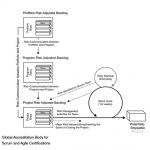How is risk mitigated in Programs and Portfolios?
While some risks are specifically related to individual projects, others may originate in programs or
portfolios and will generally be managed there itself. However, risks related to a portfolio or program
will also impact projects that are part of the respective portfolio or program. During risk assessment
in portfolios and programs, if it is determined that a risk may affect an individual project, relevant
information about the risk must be communicated to the Product Owner and Scrum Team.
Depending on the severity or priority, when the program or portfolio team communicates a risk that
will impact an individual project, the Scrum Team may have to stop and re-plan the current Sprint to
address the risk. For less urgent risks, the team can continue the current Sprint and address the risk in a
subsequent Sprint.
In Program
1. When program risks are identified, the Program Product Owner should enter them in the
program Risk Adjusted Prioritized Product Backlog, assess the proximity, probability, and impact
of each identified risk in order to prioritize it and determine the appropriate responses at a
program level.
2. The Program Product Owner will also need to communicate the risks to relevant stakeholders
and the project teams. In some cases, the program team would have to assume ownership of
specific risks.
In Portfolio
1. When risks in Portfolio are identified, the Portfolio Product Owner will need to capture them
and assess the proximity, probability, and impact of each identified risk in order to prioritize it
and determine the appropriate response for the portfolio.
2. The Portfolio Product Owner will also need to communicate the risks to the relevant
stakeholders, the program teams, and the project teams. In some cases, the portfolio team may
have to assume the ownership of specific risks.







